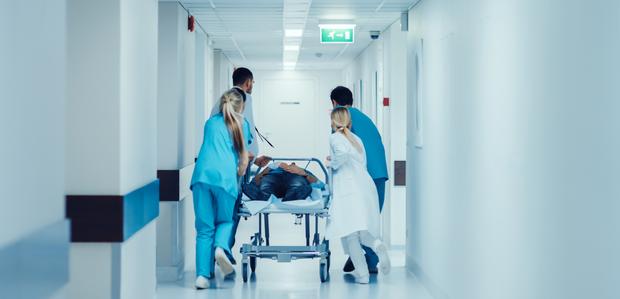Department of Critical Care

Critical Care, as the name suggests is critical in the survival of any seriously ill patient. These patients need the treatment decisions of well-experienced doctors, monitoring by high-tech equipment, and care by experienced and empathetic staff. And the Critical Care facility of Gleneagles HealthCity Chennai is a perfect mix of all these.
The intensive care unit has specially trained staff, which includes doctors, surgeons, assistants, specialists, dieticians and nurse practitioners. The team of doctors and other support professionals in the intensive care unit are trained at elite medical institutions and have extensive experience in managing all kinds of critical clinical conditions across the age group of patients.
Well-maintained wards with high-precision monitoring devices, advanced equipment, high standards of infection control measures and a team of highly specialized Critical Care experts ensure that we remain at the forefront of Critical Care in the country.
We also have trained physicians guided by the senior doctors who are available at the Critical Care ward round the clock to closely observe the patients with critical illness till they recover.
Lists of treatments are offered at the Gleneagles HealthCity Chennai. They are mentioned below:
Several treatments are performed, some of which are listed below:
- A serious accident
- Severe head injury
- Severe third-degree burns
- Heart Attack
- Stroke
- Sepsis
- Pneumonia
PROCEDURES
Mechanical Ventilation
Mechanical Ventilation is a form of artificial respiration that uses a ventilator, which is a breathing machine, to assist the patients with their breathing. It is used when the Lungs are not functioning properly. This breathing support helps in getting enough oxygen to the body and also helps in the removal of carbon dioxide from the body. Mechanical ventilation is used in the ICU when patients are not strong enough to breathe on their own so they take complete support of the machine, ventilator. Doctors take extreme care to prevent the patient from developing infections in the Lungs, especially pneumonia.
Mechanical ventilation involves the penetration of an instrument through the mouth or the skin. There are two main modes of mechanical ventilation and they are positive pressure ventilation, where air is pushed into the trachea, and negative pressure ventilation, where air is sucked into the Lungs.
Electrocardiogram (ECG)
An Electrocardiogram (ECG) is a test that is commonly performed to check the electrical activity of the Heart. An ECG shows the Heart’s electrical activity by tracing lines on paper. These tracings which have spikes and dips are called waves.
An ECG is performed to find the cause of unexplained chest pain. This could be caused by a Heart Attack. It also helps in finding the cause of the symptoms of the Heart Disease. The symptoms include shortness of breath, dizziness, and palpitations. The other uses of ECG are to find out the thickness of the walls of the Heart, to check if the medicines used to treat the Heart are working properly and also to check the health condition of the Heart when other diseases are present.
Arterial Line
An Arterial Line is a catheter that is inserted into an artery, as is the case for IVs. They may be inserted into the wrist or groin. The arterial line is a way to constantly monitor and measure the Blood Pressure of the patient. This constant monitoring of the Blood Pressure is essential to treat the patient safely. Arterial lines can be used in patients with very high or low Blood Pressure. It also provides access to frequent blood sampling, as the blood can be withdrawn from the patient with the help of the catheter.
An arterial line is mostly inserted in the radial artery of the wrist or Brachial Artery at the elbow. Insertion is usually painful so this procedure is performed under local anesthesia. Arterial lines are typically inserted by physicians, surgeons, Anesthesiologists or nurses.
Cardiopulmonary Resuscitation (CPR)
Cardiopulmonary Resuscitation (CPR) is the combination of life-saving measures performed to restart Lung and Heart function in a patient who has stopped breathing or whose Heart has stopped beating. This condition is called Cardiac Arrest. A few methods may include applying pressure on the chest attempting to restore the Heart rhythm to normal (with an electric shock) and also administration of medications and artificial respiration using a face mask or breathing tube.
When the Heart stops, the lack of oxygenated blood can cause Brain Damage. In this condition, a person may die within 5-10 minutes. CPR can keep oxygenated blood flowing to the Brain and other vital Organs until any other medical treatment can restore a normal Heart rhythm.
Our Doctors
View all
Dr Sivasailam R
Clincal Lead
MBBS, MD, IDCCM

Dr Madhana Gopal
Consultant
MBBS, MD, IDCCM
Why Choose Us
-
PATIENT EXPERIENCE
Your care and comfort are our top priorities. We ensure that the patients are well informed prior to every step we take for their benefit and that their queries are effectively answered.
-
LATEST TECHNOLOGIES
Your care and comfort are our top priorities. We ensure that the patients are well informed prior to every step we take for their benefit and that their queries are effectively answered.
-
PROVIDING QUALITY CARE
Your care and comfort are our top priorities. We ensure that the patients are well informed prior to every step we take for their benefit and that their queries are effectively answered.







